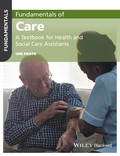Fundamentals of Care
A Textbook for Health and Social Care Assistants
Fundamentals

1. Auflage März 2017
280 Seiten, Softcover
Wiley & Sons Ltd
Fundamentals of Care is an accessible introductory textbook for all health care assistants; assistant practitioners and social care support workers who are undertaking the newly introduced, mandatory Care Certificate, as well as offering a resource for providing care and support.
Practically focused, each chapter begins with the outcomes associated with each standard, which helps contextualise and focus the reader on the content and relevance to the Care Certificate. The book also includes exercises to encourage the reader to stop, look, listen and act, thinking cap activity promotes further thinking and application to care and support provision along with case studies and resource files.
Written to help the reader come to terms with the role and function of the heath and care assistants, Fundamentals of Care offers support to those undertaking the Care Certificate and to assist those who already work as health and care assistants, helping them in their quest to enhance safe and effective care.
Acknowledgements
How to use your textbook
Chapter 1 Health and social care provision in the UK
Introduction
An historical view
The NHS in the four countries
Provision of services
Regulation and monitoring of services
Professional regulation
Primary care services
Secondary care services
Tertiary care services
Ambulance trusts
Mental health trusts
Community health services
Social care and support
Assessment of care needs
Assessment of health needs
Chapter summary
Chapter 2 Working with others, teamwork
Introduction
Teamworking
Teams and teamworking
Team dynamics
Barriers to effective teamworking
Conflict
Chapter summary
Chapter 3 Understanding your role
Introduction
Who are you?
Job description
Agreed ways of working
Policies and procedures
Codes of conduct
Responsibility
Accountability
Delegation
Relationships
Chapter summary
Chapter 4 Your personal development
Introduction
Lifelong learning
How learning takes place, learning styles
Strategies to help with learning
Personal development plans
Appraisal
Your personal development plan
The personal development portfolio
Supervision
Training and development
Core learning
Giving and receiving feedback
Chapter summary
Chapter 5 Duty of care
Introduction
Duty of care
Your duty of care
Concerns
Promoting independence
Providing information
The constitution, complaints, comments and compliments
Raising concerns
Untoward incidents
Negligence
Conflict
Responding to conflict
Chapter summary
Chapter 6 Equality and diversity
Introduction
Legislation
Equality duty
Human Rights Act
Defining terms
Labelling, stereotyping and prejudice
Inequality
People with learning disabilities and those with mental health problems
Cultural sensitivity
Chapter summary
Chapter 7 Working in a person?]centred way
Introduction
Working in a person?]centred way
Person?]centred values
Enabling
Coordinated care
Personalised care
Person?]centred planning
Supporting people
Advanced care planning
The environment of care
Minimising discomfort, distress or pain
Responding to a person's discomfort
Self?]esteem
Personal identity
Promoting wellbeing, identity and self?]esteem
Chapter summary
Chapter 8 Communication
Introduction
Care, compassion and communication
Communication
Types of communication
Verbal communication
Non?]verbal communication
Working in teams
Communication and language needs
Communication aids
Barriers to effective communication
Strategies to reduce barriers to communication
Preserving confidentiality
Chapter summary
Chapter 9 Privacy and dignity
Introduction
Protecting information
Disclosure
Implementing respect, privacy and dignity
Informed choice and choosing options
Assessing risk
Equality and diversity
Promoting independence
Chapter summary
Chapter 10 Fluids and nutrition
Introduction
Food and drink safety
Protecting people
Personal protective equipment in food hygiene
Nutrition and hydration
The Eatwell plate
Hydration
Poor hydration and nutrition
Helping people with their nutrition and hydration
Chapter summary
Chapter 11 Awareness of mental health, dementia and learning disability
Introduction
Mental health conditions
Service provision
Depression
Anxiety
Bipolar disorder
Psychosis
Dementia
Learning disabilities
The social model of disability
Assessing and making a diagnosis
Mental capacity
Assessing capacity
Chapter summary
Chapter 12 Safeguarding adults
Introduction
Safeguarding
Types of harm and abuse
Safeguarding vulnerable adults: the principles
A person?]centred approach
Safeguarding Adults Boards
Identifying and managing risk
Suspected or disclosed abuse
Reporting concerns
Chapter summary
Chapter 13 Safeguarding children
Introduction
Safeguarding and welfare
Child abuse and maltreatment
Impact of parents or carers on a child's health and wellbeing
Types of abuse
Physical abuse
Emotional abuse
Sexual abuse
Neglect
Radicalisation
Trafficking
Female genital mutilation (FGM)
Gang abuse
Children and social media
The rights of the child
What to do if you have concerns of suspected or alleged abuse
Escalating concerns
Chapter summary
Chapter 14 Basic life support
Introduction
The heart
The lungs
Basic life support
The AVPU scale for checking a response
Cardiopulmonary resuscitation (CPR)
Airway obstruction
Documentation
Automatic external defibrillators
Chapter summary
Chapter 15 Health and safety
Introduction
The law
Health and safety policies
Hazards in the workplace
Workplace hazards
Working with hazardous substances
Reporting health and safety hazards
Risk assessment
Accidents and incidents
Medicines
Moving, handling and assisting
Fire safety awareness
Working safely
Managing stress
Chapter summary
Chapter 16 Handling information
Introduction
Key legislation
The electronic patient record
Making concerns known
The use of social media
Chapter summary
Chapter 17 Infection prevention and control
Introduction
Roles and responsibilities
Transmission of infection
The chain of infection
Breaking the chain
Safe disposal of waste
Sharps disposal
Safe management of laundry
Personal protective equipment (PPE)
Chapter summary
Chapter 18 Questions you always wanted to ask
Introduction
Chapter summary
Annotated bibliography
Index


